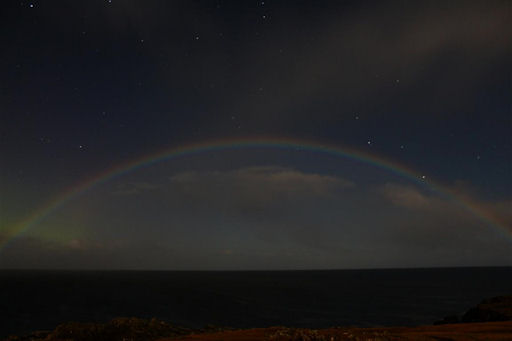DECLINING CHANCE OF FLARES: Big sunspot AR1618 is in decay, and it hasn't unleashed a strong flare in more than 24 hours. Nevertheless, the sunspot retains a complex ('beta-gamma-delta' class) magnetic field that harbors energy for X-class eruptions. Significant flaring is still possible this weekend. Solar flare alerts: text, voice.
GEOMAGNETIC STORM WATCH: A geomagnetic storm is brewing around Earth's poles following a CME strike on Nov. 23rd. A second CME is en route, due to arrive on Nov. 24th. NOAA forecasters say there is a 65% chance that the second strike will trigger strong storms at high latitudes. Aurora alerts: text, voice.
Auroras from the first CME strike on Nov. 23rd were weak. On the Isle of Lewis in the Outer Hebrides, photographer John Gray knew just where to look--at the end of the rainbow:
"It was not a very strong aurora, but there all the same," says Gray. "I hope it gets stronger [when the second CME arrives]."
For readers who are puzzled by the apparition of a rainbow at night: This is a lunar rainbow or 'moonbow' caused by bright moonlight reflecting from water droplets in distant rain clouds. Auroras are never found at the end of daytime rainbows, but the end of a lunar rainbow is often a good place to look.

![]()
Solar wind
speed: 393.9 km/sec
density: 12.7 protons/cm3
explanation | more data
Updated: Today at 1515 UT
![]()
X-ray Solar Flares
6-hr max: C3 1340 UT Nov24
24-hr: C3 1340 UT Nov24
explanation | more data
Updated: Today at: 1500 UT
![]()
![]()
![]()
Daily Sun: 24 Nov 12
![]()
![]()
Decaying sunspot AR1618 poses a slight threat for X-class solar flares. Credit: SDO/HM



